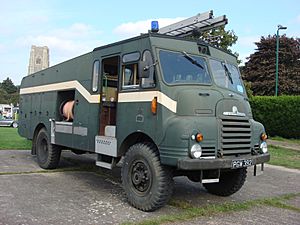Auxiliary Fire Service facts for kids
The Auxiliary Fire Service (AFS) was a group of volunteer firefighters in Great Britain. It was first created in 1938, just before World War II, to help local fire brigades. Their job was to provide extra support during emergencies. In August 1941, during the war, the AFS and local fire services were replaced by the National Fire Service.
After the war, the AFS was started again in 1948. This time, it was part of the UK's plan to respond to a possible nuclear attack during the Cold War. The AFS was finally ended in the UK in 1968.
People who joined the AFS were volunteers. They usually worked part-time without pay. However, they could be called up for full-time paid work if there was a big emergency. Both men and women could join, with women often helping with office work and planning.
Contents
How the AFS Was Organized
The Auxiliary Fire Service had a presence in every major town and city area, including London. Each AFS group was led by a commandant. Larger areas also had deputy and assistant commandants.
The AFS had its own fire stations. Each station was managed by a section officer. These stations were then divided into smaller areas called fire beats, each led by a patrol officer.
AFS Ranks
The AFS had different ranks for its members:
- Auxiliary fireman (the basic rank for firefighters)
- Patrol officer
- Section officer
- Deputy commandant
- Commandant (the highest rank)
During its early years, the AFS faced a challenge. Different local fire brigades used different types of equipment. For example, their fire hydrants (where firefighters connect their hoses to get water) were not all the same size. This made it hard for different fire teams to work together smoothly.
The AFS After World War II
The Auxiliary Fire Service was restarted in 1948. At first, they used older equipment from the wartime National Fire Service. However, the new main job of the AFS was to create mobile firefighting teams. These teams could quickly move to areas that had been hit by a nuclear attack. It was thought that local fire services might be destroyed in such an event.
Because of this new role, the old equipment wasn't good enough. So, in the 1950s, the AFS received new gear. This included 1,000 special fire engines known as Green Goddesses. These were large, self-propelled pumps. They also got Land Rovers, motorcycles, and other support vehicles. These included trucks to carry pipes, mobile kitchens, and vehicles for carrying foam and water.
AFS Mobile Columns
It was believed there would be some warning before a nuclear attack. This would allow regular fire equipment to join the AFS teams. These teams would then head to wherever they were needed. These were very large teams, designed to be self-sufficient. This meant they could operate on their own for a while.
The teams included:
- Motorcycles: To go ahead and control traffic or carry messages.
- Control vehicles: Like the Land Rover, for managing the team.
- Field telephone equipment: For communication.
- Firefighting vehicles: To put out fires.
- Pipe, water, and foam carriers: To bring supplies.
- Breakdown trucks: To fix broken vehicles.
- Supply and catering vehicles: For food and other needs.
All AFS equipment was painted a dark green color. They also had large "AFS" signs on their doors.
AFS in Action
Most fire stations had an AFS section. This meant AFS crews often helped regular firefighters at fires and accidents. They provided important help at some very big fires, like those at Billingsgate Market and a wood yard in Barking.
AFS members were trained in firefighting by their own officers and by full-time firefighters. Many also learned advanced St John Ambulance first aid. This training was often very useful at major incidents where people were injured.
The Green Goddess Fire Engines
The Green Goddesses were very important. They were used in two main types. The first was a 2-wheel drive version. It carried about 1,800 liters (400 gallons) of water and had a powerful pump. Later versions were 4-wheel drive, carrying about 1,360 liters (300 gallons) of water, but with the same powerful pump.
Their main job was to act as a mobile pump. They could connect together using large 150 mm (6 inch) hoses. This allowed them to move huge amounts of water, about 4,500 liters (1,000 gallons) per minute, over long distances. This was especially useful for fighting very large fires. They often used inflatable dams as a water source, which could be filled by smaller, portable pumps. Water could also be taken from rivers or lakes using special "Bikini Units." These units floated on the water and could pump directly from it.
After Disbandment
The AFS was always a civilian organization. It had no connection to the British armed forces, even though they used a similar green paint color. When the AFS was ended in 1968, some of the Green Goddesses were sold off. However, the 4-wheel drive versions, Land Rovers, and other vehicles were stored away for future emergencies.
Local fire brigades could borrow these stored vehicles if they had special needs. For example, 500 Green Goddesses were brought out of storage during a drought in 1976. The government also used Army and Royal Navy staff to operate these vehicles during firefighter strikes.
By 1984, there were still many AFS vehicles in storage. This included over 1,000 Green Goddess pumps and hundreds of other support vehicles. Most of these were later sold off in 2005. Many went to fire brigades in developing countries, especially in Africa. Some were also bought by people who wanted to preserve them as historical vehicles.
See Also
- 1941 Old Palace School bombing
- Volunteer fire department
- Cyril Demarne


